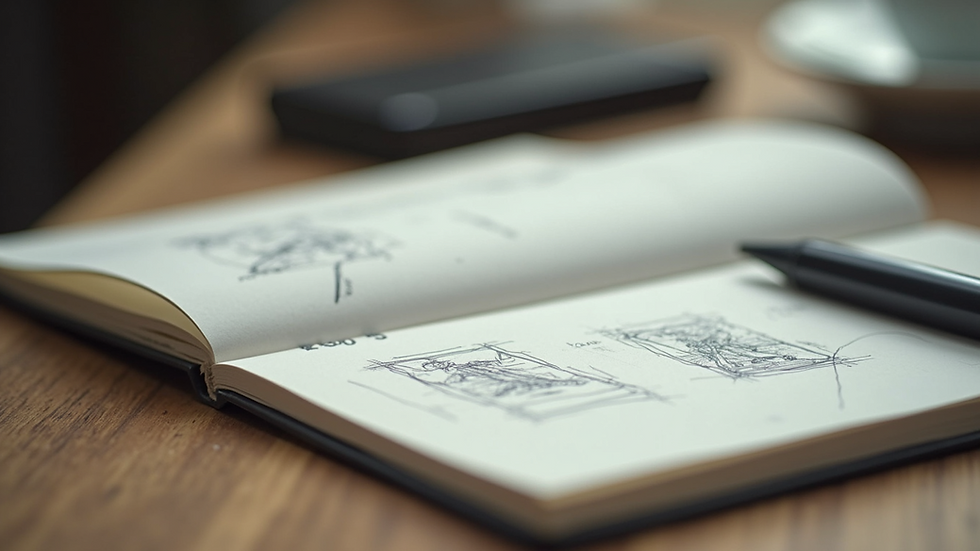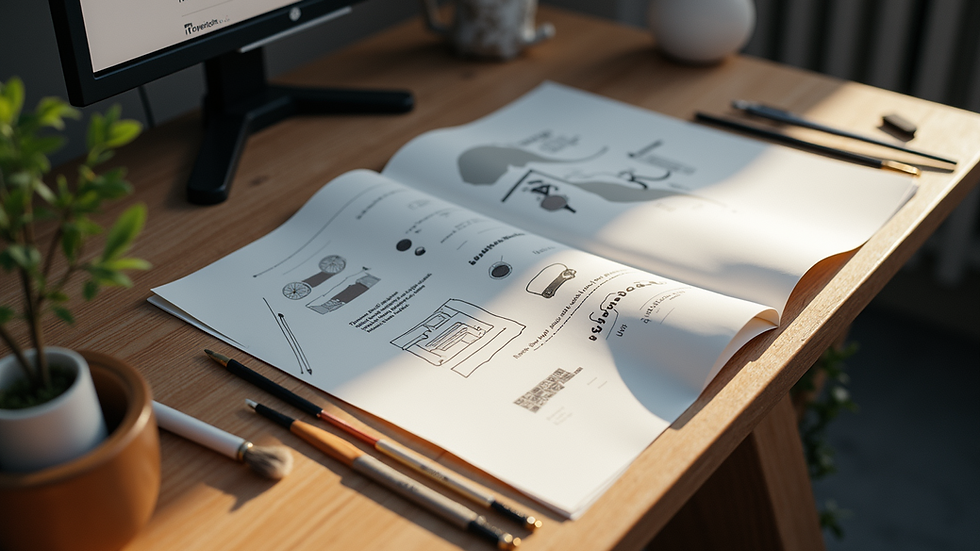Web designer
- AMAGLO LORD LAWRENCE
- Jul 11
- 5 min read
In today's digital age, a well-designed website can make or break a business. With 75% of users making judgments about a company's credibility based on their website's design, the role of a web designer has never been more crucial. A web designer blends creativity and technical knowledge to build websites that are not only visually appealing but also functional and easy to use. In this post, we discuss how to become a web designer, the essential skills required, and tips to stand out in this competitive market.
Understanding the Role of a Web Designer
A web designer shapes the overall appearance of a website. This includes decisions about layout, color schemes, fonts, graphics, and how users interact with the site. For example, effective use of white space can improve readability, which keeps visitors engaged and reduces bounce rates.
To excel in this role, you must grasp key design concepts such as balance, contrast, and alignment while being aware of the latest web technologies like HTML, CSS, and JavaScript. Staying informed about design trends, such as minimalism or dark mode, is also essential for creating contemporary and captivating websites.
Web designers have a unique opportunity to enhance user experience. By expertly blending artistic vision with technical know-how, they influence how users perceive and navigate digital platforms.
Essential Skills for Web Designers
Creativity and Design Expertise
Creativity is at the heart of web design. Being able to create visually appealing sites that meet client goals is crucial. For example, a study found that colors can increase brand recognition by 80%. Understanding color theory, typography, and layout principles directly impacts how users engage with a website.
Familiarity with design tools such as Adobe Photoshop, Illustrator, and Figma is essential. For instance, using Adobe XD allows designers to create interactive prototypes, which is vital in getting client approvals and user feedback before development.
Technical Proficiency
A solid technical foundation is necessary for a web designer. Knowledge of HTML and CSS is essential, as these languages serve as the backbone for web creation. You should also consider expanding into JavaScript for dynamic content, as pages with interactive elements can boost user engagement by up to 40%.
Responsive design is a growing necessity, with approximately 60% of web traffic coming from mobile devices. Understanding frameworks like Bootstrap, which facilitates mobile-friendly design, can further enhance your capabilities.
User Experience (UX) Understanding
A strong grasp of user experience design is vital. A user-centric approach ensures websites are intuitive to navigate. For instance, websites that utilize user feedback in their design process can increase their conversion rates by up to 200%.
Become acquainted with practices such as creating user personas and conducting usability testing. These steps can help you identify and address common pain points that users face while interacting with a website.
The Design Process
Research and Discovery
Thorough research is the first step in the design process. Study the target audience, analyze competitors, and observe industry trends.
[Image Placeholder: Image of a notepad and research materials]

This step helps you understand user expectations and successful practices in your niche. Creating a mood board can also help consolidate your ideas and offer inspiration for upcoming designs.
Wireframing
Wireframes are essential blueprints for your website. This low-fidelity representation outlines the layout of each page without color or detailed graphics and helps visualize navigation and functionality.
Using tools such as Balsamiq or Adobe XD, you can create prototypes for client review. Getting feedback at this stage ensures you’re aligned with the client's vision before moving on to detailed design work.
High-Fidelity Mockups
Once wireframes are approved, you can create high-fidelity mockups. This phase involves integrating colors, typography, and graphics to showcase a near-final representation of the project.
Incorporate brand elements effectively and establish a visual hierarchy that helps users navigate your content intuitively.
Implementation
After mockups receive final approval, it’s time to bring your designs to life. This phase might include collaborating with developers or coding the designs yourself if you have the skills.
Testing for responsive design and cross-browser compatibility is critical. On average, 40% of users will abandon a site that takes more than three seconds to load. These tests ensure a seamless experience across all devices.
Tools of the Trade
Using the right tools is crucial for functionality and creativity in web design. Here are some recommended tools:
Design Software
Adobe Creative Suite: Industry standard tools such as Photoshop and Illustrator for graphic design.
Figma: A collaborative web-based tool that allows real-time teamwork in interface design.
Sketch: A vector-based design application favored by web designers for its straightforward user interface.
Development Tools
Code Editors: Tools like Visual Studio Code or Sublime Text can streamline your coding process with features like auto-completion and error highlighting.
Preprocessors: CSS preprocessors like SASS or LESS help simplify your stylesheets and can lead to better organization over time.
Project Management Tools
Trello or Asana: Effective tools for managing tasks, deadlines, and collaboration among team members and clients.
Building Your Portfolio
A strong portfolio is your gateway to attracting clients and showcasing your skills. Here are tips for creating an impressive portfolio:
Select Showcase Projects
Choose diverse projects that highlight your range and design capabilities. For a well-rounded portfolio, include both professional and personal works, ensuring each showcases your process, from initial research to final execution.
Detail Your Process
For each project, provide context by discussing challenges, solutions, and impacts. This narrative helps potential clients understand your methods and the value you can bring to their projects.
Keep it Updated
Update your portfolio frequently with new work and remove outdated pieces. Regular updates reflect your progress as a designer and keep your portfolio relevant to current trends.
Networking and Finding Clients
Building connections within the industry is crucial for your growth and client acquisition.
Attend Workshops and Conferences
Participating in design workshops or conferences can expose you to industry leaders and peers. Engaging in these events can lead to valuable collaborations and referrals.
Online Platforms
Tap into platforms like Behance, Dribbble, and LinkedIn to showcase your work and connect with other professionals in the field. Active engagement can open up freelance roles and opportunities for collaboration.
Social Proof
Encourage satisfied clients to share testimonials or reviews. Positive feedback serves as social proof, significantly boosting your credibility, which can attract new clients.
Continuing Education
Staying current with trends and technologies is essential in the ever-evolving field of web design.
Online Courses
Consider enrolling in online courses offered by platforms like Coursera or Udemy. These courses can help you learn new skills or refine existing ones, covering subjects from design concepts to advanced coding.
Follow Industry Trends
Stay informed by reading design blogs, attending webinars, and engaging in online forums. Resources like Smashing Magazine and A List Apart can provide valuable insights into new developments in the web design industry.
Final Thoughts
Pursuing a career as a web designer is a rewarding journey that combines creativity with technical skill. By improving your design abilities, staying up-to-date on industry trends, and cultivating a strong portfolio, you can distinguish yourself in this competitive field.
Dedication and a commitment to lifelong learning will allow you to evolve alongside the dynamic world of web design. Embrace this journey, and you will have the opportunity to influence how users interact with digital platforms daily.
[Image Placeholder: Image of a workspace filled with design materials]

Start your journey as a web designer today, and join a vibrant community of innovators shaping the future of the digital world!

$50
Product Title
Product Details goes here with the simple product description and more information can be seen by clicking the see more button. Product Details goes here with the simple product description and more information can be seen by clicking the see more button

$50
Product Title
Product Details goes here with the simple product description and more information can be seen by clicking the see more button. Product Details goes here with the simple product description and more information can be seen by clicking the see more button.

$50
Product Title
Product Details goes here with the simple product description and more information can be seen by clicking the see more button. Product Details goes here with the simple product description and more information can be seen by clicking the see more button.




Comments